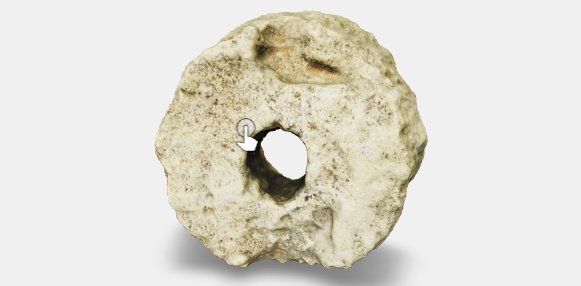A stone anchor or a deadweight/fixed mooring, roughly shaped as a doughnut. There are two perpendicular grooves in the central hole, attributable to the wear caused by mooring ropes.
The artefact does not present traces of biological colonisation, probably thanks to the petrographic characteristics of the stone that tends to disintegrate in tiny fragments.
Frost H. 1969, The stone anchors of Ugarit, in Ugaritica 6, pp. 235-245.
Frost H.1973, Anchors, the potsherds of marine archaeology: on the recording of pierced stones from the Mediterranean, in D.J. Blackman (Ed.), Marine Archaeology, London, pp. 397-406.
Frost H. 1997, Bronze age stone anchors (Eastern Mediterranean), in J.P. Delgado (Ed.), Encyclopaedia of Underwater and Maritime Archaeology, London, pp. 74-75.
Galasso M. 2000, Ancore di pietra fra archeologia ed etnografia, in Archeologia Postmedievale, 4, pp. 265-282
Gianfrotta P. A., Pomey P. 1981, Archeologia subacquea, storia, tecniche, scoperte e relitti, Milano.
Gianfrotta P.A. 1983, Recensione a Dan E. McCaslin: Stone Anchors in Antiquity, in Gnomon 55, pp. 336-339.
Gibbins D. 2001, Shipwreck and ellenistic trade, in Zofia H.A., Davies J., Gabrielsen V., Oliver G.J. (eds.), Hellenistic Economies, , London-New York,
Kapitän G. 1984, Ancient Anchors – Tecnology and Classification, in IJNA 13.1, pp. 33-44
Kingsley S.A., Raveh K. 1994, Stone anchors from Byzantine contexts in Dor Harbour, Israel, in IJNA 23, pp. 1-12
Kingsley S.A., Raveh K. 1996, The Ancient Harbour and Anchorage at Dor, Israel. Results of the underwater surveys 1976-1991, BAR Int. Series 626, Oxford.
Kourkoumelis D. 2000, The Antidragonera Wreck (Kythera, end of 4th century BC), Island in Archaeology: Vorgeschichte, Klassische Antike, Mittelalter, Neuzeit (Internationaler Kongress 10-12 Juli 1998, Starnberg), in Archäologie unterWasser 3, München,
Kourkoumelis D. 2004, Les ancres pyramidales en pierre. Problèmes et techniques d’ancrage des navires au IV siècle av. J.-C., in Brun J.P., Philippe J. (Eds.), Texnai. Techniques et societès en Mèditerranèe, Paris, pp. 649-661.
Mccaslin D.E. 1980, Stone Anchors in Antiquity: Coastal Settlements and Maritime Trade-Routes in the Eastern Mediterranean ca. 1600-1050 B.C., Göteborg.
Nibbi A. 1993, Stone anchors: the evidence re-assessed, in The Mariner’s Mirror 79, pp. 5-26.
Raban A. 2000, Three-hole composite stone anchors from a medieval context at Caesarea Maritima, Israel, in IJNA 29.2, pp. 260-272.
Riccardi E. 1996, Ancore, in Ciciliot F. (ed), Navalia – archeologia e storia, Savona, pp. 9-30
Tòth J.A. 2002, Composite stone anchors in the ancient Mediterranean, in Acta Archaeologica Academiae Scientiarum Hungaricae 53, pp. 85-118.
Wachsmann S. 1998, Seagoing Ships and Seamanship in the Bronze Age Levant, College Station- London .



